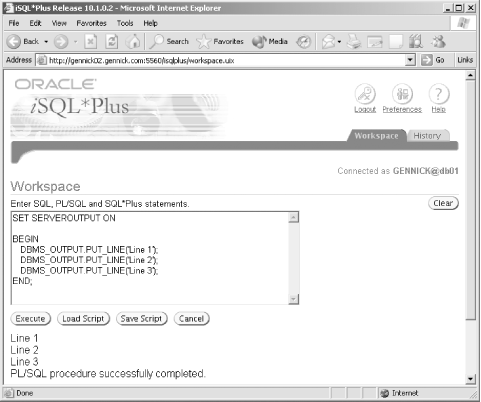Working with PL/SQL
There's not much to say about executing PL/SQL blocks via iSQL*Plus. You execute those in much the same way as you execute statements. You do not need to include the forward slash that command-line SQL*Plus requires following a PL/SQL block, but you do need to be sure to include the semicolon following PL/SQL's END keyword. As in command-line SQL*Plus, you'll want to SET SERVEROUTPUT ON if your PL/SQL block uses DBMS_OUTPUT to return results. Figure 3-11 demonstrates.

Figure 3-11. Executing a PL/SQL block
Figure 3-11 was
created using iSQL*Plus from Oracle Database
10g with the default setting of PREFORMAT OFF.
Because the output is not the result of a query, it's not in the form of
an HTML table. Examine the HTML source, and you'll see that <br> tags separate the three lines of
output. Interestingly, if you SET MARKUP HTML PREFORMAT ON,
iSQL*Plus correctly omits the <br> tags and incorrectly omits wrapping
the output in <pre> and
</pre> tags. Thus, with
PREFORMAT ON, the results from executing the block in Figure 3-11 would all run
together on one line:
Line 1 Line 2 Line 3 PL/SQL procedure successfully completed.
No doubt this behavior is a bug. It is present in Oracle Database 10g Release 1, but I hope it will be fixed in a later release. In the meantime, if you encounter difficulty with line breaks in your DBMS_OUTPUT results, you may find that a SET MARKUP HTML ...
Get Oracle SQL*Plus: The Definitive Guide, 2nd Edition now with the O’Reilly learning platform.
O’Reilly members experience books, live events, courses curated by job role, and more from O’Reilly and nearly 200 top publishers.

